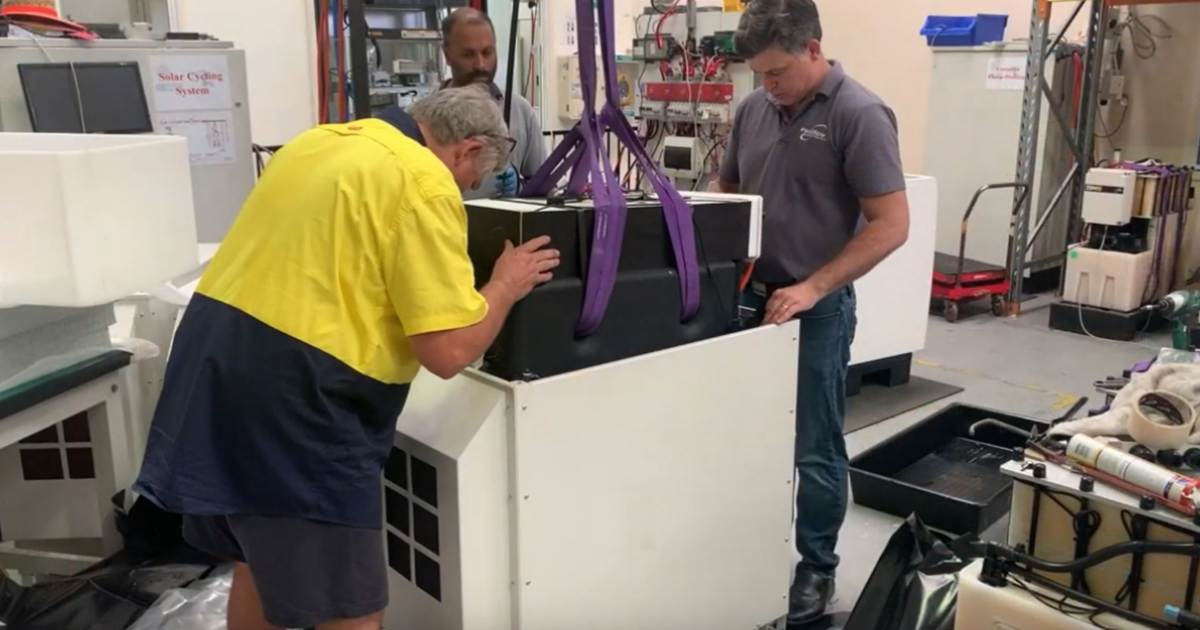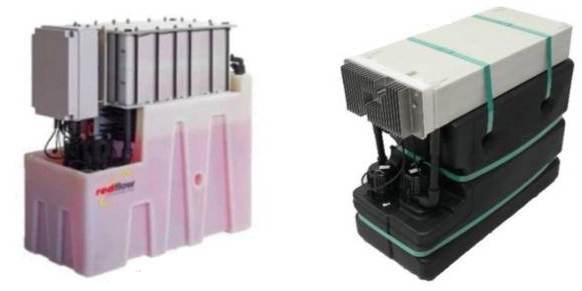Australian energy storage company Redflow has announced the first customer trial of its new Gen3 flow battery system.
Redflow manufactures the world’s smallest commercially available flow battery – the ZBM2 (commercial/industrial) and the ZCell (residential – based on ZBM2). Redflow’s technology involves a zinc bromine solution that flows between two tanks. As the battery charges, the zinc is extracted from the liquid and stored separately on plates (plating). When discharging, the zinc goes back into the liquid (deplating). We have a bit more information on how flow batteries work here.
The ZBM2 and ZCell have 10kWh usable capacity. Unlike other battery technologies where capacity is gradually lost over time, Redflow says its battery can deliver 100% of the rated system capacity daily over a 10 year period without degradation. At its end of life, the battery’s non-flammable zinc bromine electrolyte solution can be purified and re-used.
Gen3 To Help Address The Cost Barrier
There has been significant interest in Redflow batteries, but the company has experienced its fair share of challenges – one of them being the cost of its energy storage solutions. The last price we had for the ZCell (back in 2018) was around the $12,600 mark excluding an inverter and installation.
The batteries were originally manufactured in Mexico, but operations were shifted to Thailand in order to reduce costs. To push the price down further, the company has been working on a new model called the Gen3.
“With Gen3, we are confident of achieving a 30% reduction in manufacturing costs through supply chain and engineering productivity impacts,” says Redflow CEO and Managing Director Tim Harris.
Some of the savings have been achieved through a new side-by-side tank design. There’s also been a major upgrade to the electronics system controlling the battery, a cooling system redesign and significant changes to the design of the “stack”, again cutting costs. The battery stack contains electrodes that charge the battery through the zinc deposition process and discharge it by reversing that process.
Mr. Harris says more savings can be targeted through further production and scale benefits.
“The Gen3 battery will underpin Redflow’s ability to expand into larger systems and more rapidly increase take-up of our world-leading Australian technology,” he stated.
Last week the company announced two Redflow Gen3 batteries have been installed at the premises of an off-grid customer in Mount Tamborine, Queensland. The customer, James Emmett, is very familiar with Redflow gear as he already has four ZCell units installed.
The video doesn’t provide a good look at the Gen3, so here’s an image from some months ago showing the current ZBM2 on the left and the new Gen3 on the right – but there appears to have been some further changes to the Gen3 since.
This video from July provides a brief overview of the Gen3.
The Gen 3 units will be run at Mr. Emmett’s property for “a number of weeks” before being returned for further analysis and testing, and Redflow expects to deploy other trial systems at various customer premises in the time ahead. There wasn’t any word on when the Gen 3 may be commercially released.
Big Redflow Battery System Ordered
In other recent news from Redflow, the company also announced last week it had received an order for a Large Scale Battery (LSB) comprised of 60 Redflow units – whether these will be ZBM2 or the new Gen3 isn’t clear. Redflow says it will be the largest Redflow-based energy storage system in Australia.
Western Australian stockfeed supply company Semini Custom Feeds will be pairing the LSB with a 400kW solar power system, and between the two the company expects to slash its diesel and mains grid energy costs by 80 per cent.



 RSS - Posts
RSS - Posts



What do you think of the “Redflow” Company Product and will it be successful? ….. and will it be worthwhile to buy as a residential customer?
There are many benefits to Redflow’s battery compared to lithium batteries.
– no issues with mining lithium
– don’t degrade capacity over time
– no potential to combust
– no chance of thermal runaway
– can withstand harsh conditions
– don’t degrade at higher temperatures
– don’t degrade if cycled hard and often
– simple to recycle
– Australian company
This is starting to get interesting.
Ronald’s review of Redflow batteries in 2016 suggested an installed cost of more than 60cents/KWH over the warranty period, taking into account cost of capital. That is not cost effective. If the price comes down in line with the reduced manufacturing costs, we might be getting to a point where on-grid storage looks attractive.
The relatively low efficiency of these batteries is an issue, but the fact their capacity doesn’t decline makes them attractive. Also, I get the sense that they might even be a candidate for refurbishment after 10 to 15 years, rather than replacement.
I suspect, that these really need to be installed in pairs, at least for household use, unless I am missing some thing. If so, happy to be corrected. I like these, but I think they have to be run pretty much to empty and then recharged fully, so they need to be swapped out for charging and a charged one swapped in.
Probably a swap once a day would work, or perhaps when nearly flat.
I don’t think flow batteries can be used like most cells and just flipped in an out of charge and discharge randomly. If this is so, then you are looking at a minimum of two. For some reason, this never seems to get a mention or be discussed. I seem to recall the version two, could be refurbished at the end of 10 years for a fair bit less than new price. These should be even better in that aspect, interesting to know. Also, the price of new and refurbishment would be interesting. Colin
It is not so much a matter of the charge / discharge cycle that demands multiple batteries, but the regular maintenance cycle that requires each battery to be offline for a period in order to deplate the ion exchange unit to as-new condition.
This maintenance cycle creates an issue for battery availability to the system, but it is intrinsic to the magic of a flow battery that never degrades in capacity and can be completely discharged. Every battery technology has characteristics and limitations, and the maintenance cycle is one limitation for these flow batteries.